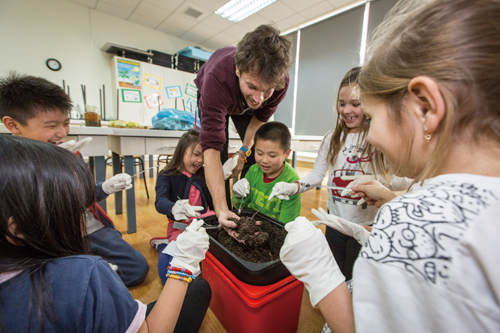
Canadian Robert Phillips teaches Science and IT at the International Montessori School of Beijing (MSB), and has been living in Beijing for two years. A farm boy from Nova Scotia, he introduced worm bins to his students as the first step in an educational journey he hopes will viscerally connect them to their food chain. I’m meeting with Phillips and his Grade 2 and 3 students to learn more about their worm bins in hopes of inspiring beijingkids readers to build their own.
Phillips constructed the worm bins at the beginning of the term but rather than digging up crawlers himself, he ordered them from Taobao. “When it gets cold and the ground gets hard it’s difficult to find them,” he says. “These are from a fishing supply store and we put about 1,000 worms in each bucket when we started.”
Having never dealt with a worm bin before, Phillips first set up a trial container at home. He wanted to ensure success in the classroom and provide himself with a backup environment if things went horribly wrong.
At home and at MSB, the worms chow down on waste produce that would otherwise end up in the trash. “I’m teaching the kids about recycling through this project, so right now I’m feeding the worms a stack of fruits and vegetables that were about to go off in our refrigerator. I also use leftover scraps from the kids’ morning snack. Some of the students also bring in food from home – such as apple cores,” he explains. “It’s a good way to get rid of all of your waste from cooking. You can use a little bit of cooked food alongside raw, but bear in mind that oils and spices don’t suit the worms’ digestion.”
He holds up two muddy-looking jars of water containing soil samples. “I put the soil in the jars with water, shake it, and let it settle. You can see that the soil we started with is poor quality and lacks any sort of structure. The particles at the top are fine, and at the bottom there’s a bit of sandiness, but there’s no organic material in there. A lot of Beijing soil is dead. The soil I bought, though really expensive, is garbage – like building rubble. I mixed a bit of potting compost into that, but the end result was still not very fertile.” The Beijing soil settled into two distinct strata – yellowish liquid and fine sand.
By contrast, the worm-conditioned jar is frothing, murky and filled with thick clots of sludge. “After only a week with the worms you can see that there’s more organic material; the soil is alive. If I open the bottle it smells terrible because there’s stuff decomposing in it. The worms are changing the soil.”
The worms need darkness to be comfortable. “I put a black top on the lid to keep the sun out,” says Phillips. “The worms don’t like light. They don’t like being eaten by birds either, so they hide during the day. They dry out quickly and don’t have lungs. Instead, they absorb oxygen through their skin; if they’re not kept moist they can’t breathe.”
The bottom of the bin is made of mesh. “If you don’t have a good airflow around the worm bin, it becomes anaerobic and starts to stink,” explains Phillips. “This is rotting food in a classroom, and yet it doesn’t smell. If you stick your head right in the bin, it smells like rainforest.” I gingerly lower my face toward the worm bin and take a quick sniff – it smells like fresh, clean earth.
Smiling at my hesitation and surprise, Phillips goes on to explain the drainage system and one of the beneficial by-products of a worm bin. “The bin underneath has holes in it so that any liquid can drain out. The liquid is called ‘worm tea’ and it’s an amazing fertilizer. You can add it to water and use it to give your plants a blast of nutrients.”
Having inhaled the bouquet of worms and dirt, it’s time to take a closer look at the wriggling critters themselves. The kids eagerly begin parting the earth with spoons.
As we trawl through the bin, Phillips finds and removes a sticker from a banana peel. “They can’t break this down,” he says. “They love the bananas themselves, though; you can tell what foods they like, because they go for those first. Orange peels and onions are not so popular.”
Pedro Febles (age 8) spots the mother lode – a writhing ball of fat, juicy worms – and gently encircles a handful. I ask him what he thinks of them: “I like them. Worms help us. I don’t think they’re gross or scary and I don’t mind picking them up.” Rather you than me, kid.
Alongside the worms, we spot mites and a mosquito. “The bins are a complete ecosystem,” says Phillips. “There’s a really big bacterial component, as well as mould growth. Worms can’t bite food; it has to decompose until it’s soft so they can eat it. If you cut it up, it starts to decompose faster and the worms can work on it more easily.”
“A worm can eat half its body weight a day,” Phillips explains. “Though we haven’t really tested their capacity yet. One of the experiments I’d like to have the kids do weigh all the food we put in over a month and see how many days it takes to break down.”
We move onto feeding time. The kids chop and add the fruits and vegetables, sprinkling dirt over them. Soil covering encourages bacterial and mould growth. “It’s so dry in Beijing that the food dries out and becomes hard if it sits on top of the soil. Then it takes the worms a really long time to digest, so you want to keep it moist and covered in bacteria,” says Phillips.
Because the ideal ratio of food for worms is 70 percent greens to 30 percent browns (greens are high in nitrogen and browns are a source of carbon), the students also add paper.
“For browns, you can use paper, coffee grounds, leaves, or egg shells. Egg shells are an effective way to lower the acidity of the soil,” adds Phillips. “If the soil starts to smell or you get a lot of mites, that’s a sign that it’s becoming acidic. Over time, the worms’ castings become increasingly acidic. It can become toxic if you leave them in too long. After three months, we’ll need to pull out a bunch of the soil that they’ve been working and introduce a lot more bedding material for them.”
Having been served their two-course meal, it is time for the worms to enjoy a little drink. “Nice and slowly, we’re going to dribble water over all of it,” instructs Phillips. “You’re doing a great job,” he tells Bright Deng (age 8), who mans the watering can.
“There’s a part of the worm called the saddle. It’s a different color and a little fatter. It produces mucus to help the worms move through the soil. When they’re mating, they create extra mucus that forms a cocoon for up to 20 eggs. We haven’t seen any cocoons yet,” says Phillips.
In the future, he intends to use the worms to teach his students about the reproductive cycle. “When we got the worms, most of them weren’t mature. When a worm matures, the saddle becomes very distinct – thicker and with a distinctive coloration. Over the last three weeks, they’ve become closer to maturity. I would expect in the next couple of months they’ll start to have babies.”
The worm bins provide many other teaching opportunities, as well as simply appealing to Phillips’ inherited love of dirt. “I appreciate any excuse to have worms in the classroom,” he jokes.
As the kids wash their hands, Phillips explains that the worms are part of an ambitious larger-scale project that he is looking to develop at MSB. “My hope is to do a lot more gardening, have the kids dig through mud and be involved in dirt. I want to get them growing their own food and seeing the complete cycle. That’s really valuable for developing the notion of ecosystems and how we fit into them – fostering a sense of what’s worth protecting. I’m trying to give the kids a more holistic sense of where food comes from and what to value within the food chain.”
In an ideal world, Phillips would garden outdoors on a grander scale and deal with all of the food waste from the school lunch program. However, Beijing’s air quality means that time outdoors is not always guaranteed. “Being able to do things inside has greater value here. I’d also like our indoor gardening to be replicable at home by interested families,” says Phillips. “We’ll start with tomatoes in buckets. They won’t be ripe by the summer holidays, but I can send a tomato bucket home with a kid and hopefully I’ll find another to look after the worm bin.”
Phillips believes that helping kids make the connection between the tomato on their plate, the scraps in the worm bin, the conditioned soil, and the growing tomato plant, has the power to radically alter how they view food and the planet.
“If I can get this soil into food that kids can eat – even if we just make a really simple salad and everyone gets a bite on a cracker – that forms a really strong connection between where our waste goes, how it can be recycled, and how we can use the recycled material for food production.”
Phillips stresses that families can easily replicate the worm bins at home; see Resources below to get started.
Resources
Complete How-To
Complete step-by-step instructions on how to build and maintain a worm bin. www.nyc.gov/html/nycwasteless/downloads/pdf/materials/wormbin.pdf
Worm Bin IKEA Hack
Instructions for a worm bin based on an IKEA storage container. www.instructables.com/id/Simple-DIY-Wormery
Photo by Mitchell Pe Masilun
This article originally appeared on p40-43 of the beijingkids March 2014 issue.
Check out the PDF version online at Issuu.com



